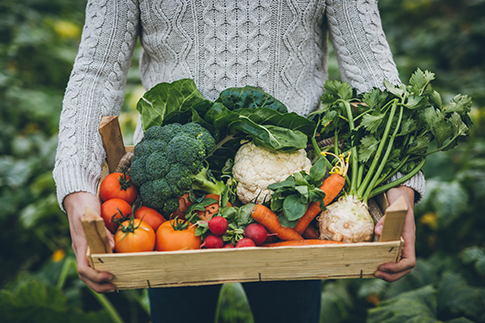How to create a garden in Quebec

Creating a vegetable garden in Quebec is easier than you think. Follow these gardening tips to successfully grow vegetables in Quebec and enjoy an abundant harvest all summer long.
What’s the best location for a vegetable garden?
The location of your garden directly influences the growth of your fruits and vegetables.
Shelter your vegetable garden from prevailing winds to prevent damage and drying out.
Plant your garden with a north-south orientation and away from mature trees to maximize sun exposure.
Ensure 6 to 8 hours of direct sunlight per day for optimal growth of your crops.
Taking care of your soil for best results
Fertile soil for vegetables is key to growing healthy and tasty produce. To start a vegetable garden, spade the soil deeply. Adopt good soil management practices. Add organic fertilizers to improve texture and provide nutrients.
Analyze your soil’s fertilization needs in a lab or with a home test kit. Usually, loosening the soil without turning it over before adding fertilizers is sufficient. The goal is to maintain soil biological activity. A good balance of nutrients is essential, especially for leafy vegetables like lettuce and spinach.
Good to know: Natural mulch helps retain soil moisture and reduces weed spread. Well-drained soil rich in organic matter promotes healthy plant roots development.
Choosing and positioning your vegetables strategically
Follow these tips to maximize the growth of your crops:
Position taller plants to the north so they don’t shade shorter ones.
Select easy-to-grow vegetables: lettuce, potatoes, pole beans, radishes, beets, cucumbers, and root vegetables like carrots.
Add high-yield plants. Plant cherry tomatoes and other tomato varieties. Space your plants about 20 cm apart to avoid root competition.
Optimizing vegetable production with cultivation techniques
Crop rotation techniques: Change the type of crop each year to prevent soil depletion:
In the first year, fertilize the soil with rich composts and prioritize nutrient-demanding plants.
In the second year, plant moderately demanding vegetables, like leafy greens.
In the third year, plant legumes or root vegetables that require fewer nutrients.
Intercropping: Plant fast-growing vegetables like radishes, arugula, or spinach between rows of slow-growing vegetables (tomatoes, peppers, cucumbers) to maximize space and harvests.
Succession planting: Plant fast-growing vegetables every 2 to 4 weeks for continuous harvests throughout the growing season.
ALT: A person carries freshly picked vegetables from the garden.
Indoor seedlings: A head start for an early harvest
Starting seeds indoors is a great way to save money and enjoy an early harvest. When should you start your seedlings? The indoor seedling period varies from early March to late April, depending on the type of vegetable.
Early March: onion, parsley, leek
Late March: eggplant, pepper, tomato
Mid-April: Swiss chard, broccoli, lettuce
How to prepare your seedlings
Fill each seed tray with moist, organic-rich potting mix.
Ensure your containers have drainage holes to prevent excess moisture.
Leave one or two centimetres at the top.
Level the surface by lightly pressing the soil.
Distribute the seeds according to the manufacturer’s instructions.
Cover with a thin layer of soil and press the surface so the planted seeds adhere well to the soil mix.
Water by immersion by soaking the base of the container in water.
Place everything in a warm (21 to 24°C) and humid place until the seedlings emerge.
How to maintain humidity
To maintain constant humidity, place a clear plastic dome over the trays. After germination, remove the dome. Place the seedlings near a south or west-facing window and lower the temperature by a few degrees. If sufficient lighting is not available, use fluorescent grow lights.
Are you more of a visual person? Watch our step-by-step video Preparing a vegetable garden.
Growing vegetables on your balcony: It’s possible!
Even in a small space, you can successfully grow vegetables. You can grow almost all vegetables, such as tomatoes, peppers, cucumbers, carrots, and beans, in pots on a balcony vegetable garden. The secret to success? The location must receive at least 6 hours of sunlight.
If not, opt for less demanding plants like lettuce. Also, choose compact or dwarf varieties.
Most herbs grow easily in pots. The easiest aromatic herbs to grow are rosemary, thyme, sage, marjoram, parsley, chives, oregano, basil.
Choose containers of good size (minimum 25cm) with drainage holes. This allows the roots to develop well. Remember that the space between plants depends on their mature size. Ensure you respect the recommended distances.
Good to know: Potted gardens require regular watering, especially during heatwaves.
Raised garden beds: Ideal solution for difficult soil
A raised garden bed is an excellent alternative if your soil is poor, compacted, or poorly drained, or if your terrain is sloped. The main advantage of this garden is that the soil warms up quickly in the spring, allowing for earlier planting.
However, this type of cultivation requires frequent watering during heatwaves. The walls should be 15 to 45 cm high and at least 15 to 30 cm deep. This helps achieve good drainage and provides enough soil for the roots.
Growing a garden: An accessible project for everyone
Whether it’s a traditional garden, a raised bed, or a balcony garden, growing your own vegetables is within everyone’s reach. With a bit of planning and the right techniques, you’ll achieve an abundant harvest.
Don’t forget to take care of your soil (even before winter). Choose your plants wisely. Adopt practices for continuous production throughout the season.
Pests or invasive animals destroying your crops? Learn how to repel them with natural pest repellents.
Special thanks to: Montréal Botanical Garden

Benefit from personalized advice
Do you have questions about your home, need specific information, or are you looking for referrals to find an Approved Supplier?
